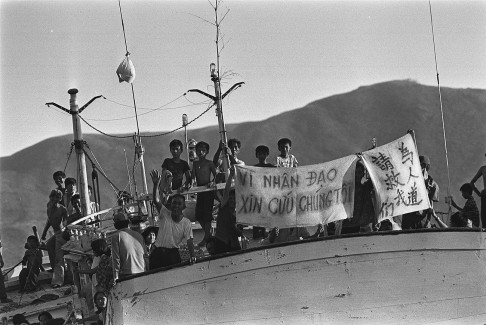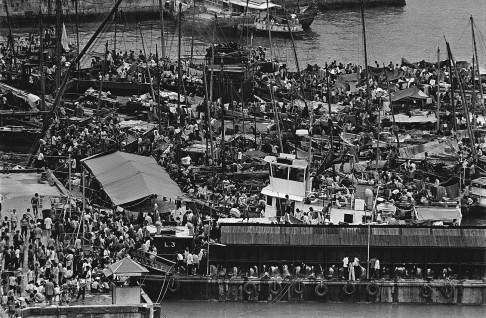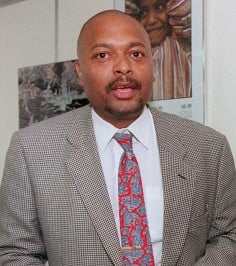The first Vietnamese boat people arrived after Saigon fell in 1975; critics say the experience still influences local policy towards refugees today
RAQUEL CARVALHOraquel.carvalho@scmp.com
PUBLISHED : Monday, 14 September, 2015, 4:18am
UPDATED : Monday, 14 September, 2015, 4:18am
The Shek Kong detention centre for Vietnamese. Photo: SCMP Pictures
Europe's unfolding refugee crisis which has seen waves of dispossessed humanity arrive on the continent's shores in makeshift boats - with drenched clothes and a sense of hope their only possessions - will evoke vivid memories for many here.
Almost four decades ago, the city - at the time a British colony - became a destination of first choice for tens of thousands of people fleeing Vietnam after 20 years of war ended in 1975 with the fall of Saigon and a communist victory over the US.
More than 230,000 "Vietnamese boat people" - as they came to be collectively known - arrived in Hong Kong and were held in a series of camps across the city. Hundreds of thousands more ended up as refugees in Indonesia, Malaysia, the Philippines, Singapore and Thailand.
 Vietnamese boat people display banners on the deck of their trawler asking to be allowed to stay in Hong Kong. Photo: C. Y. Yu
Vietnamese boat people display banners on the deck of their trawler asking to be allowed to stay in Hong Kong. Photo: C. Y. Yu
The first group arrived in Hong Kong in May 1975, and that initial influx - numbering 3,743 - was resettled overseas a year later. However, those who were to come later faced a much less fortunate fate.
Fifteen years ago - on June 21, 2000 - the last camp closed its gates, ending a turbulent three-decade period which left a legacy the city has not yet fully addressed and which had a powerful influence on how the city perceives and treats refugees.
Back then Hong Kong had to grapple with the same dilemmas Europe is experiencing today. Former colonial government Security Bureau official Clinton Leeks, who was in charge of detention policy, legislation and camps between 1980 and 1985 and then served as refugee coordinator between 1990 and 1992 - reflects now that not much could have been done differently.
The difficulty was being accountable for a problem Hong Kong had little control over
EX-OFFICIAL, CLINTON LEEKS
"We always knew in reputational terms we had little choice but to try to treat the people coming in a humane way and try to find a solution for them," he recalled. "The obvious alternative, to turn boats back to sea, would have greatly damaged us at a time when Hong Kong needed international support and understanding," Leeks told the South China Morning Post.
One of the first measures designed to dissuade Vietnamese boat people from staying in Hong Kong came in 1982, when the government set up closed camps on remote outlying islands. A few years of relative calm followed, but the number of refugees spiked again as the end of the 1980s approached.
 A total of 10,353 Vietnamese boat people arrived in Hong Kong and crowded into the government dockyard in Yau Ma Tei in the mid-summer of 1979. Photo: SCMP Pictures
A total of 10,353 Vietnamese boat people arrived in Hong Kong and crowded into the government dockyard in Yau Ma Tei in the mid-summer of 1979. Photo: SCMP Pictures
Initially, anyone fleeing Vietnam in a small boat was automatically granted refugee status, pending resettlement in a Western country. But in June 1988, the Hong Kong authorities introduced a screening policy to differentiate legitimate refugees from economic migrants.
A year later, a "comprehensive plan of action" was put in place after being approved at an international conference in Geneva. Under the plan, individuals who were denied refugee status were repatriated either in regular departure programmes or through clandestine operations. In December 1989, a "forced repatriation scheme" was implemented.
Peter Barnes, a human rights lawyer who came to Hong Kong in the early 1990s to work with the late Pam Baker - a pioneering lawyer who fought for Vietnamese refugee rights - said the British government could have handled the situation very differently.
"The government could have done their job properly in the first place," he said. "After 1988 they could have set up a proper screening system."
Critics described the screening process as deeply flawed, suffering from translation problems and bureaucracy. "There was a body of people treated profoundly unjustly, whose cases were not listened to properly or, even worse, who were insulted by the decisions being made," Barnes recalled of the repatriation process.
 Refugee Co-ordinator Clinton Leeks talks to the press about the final agreement of an orderly return programme for the Vietnamese boat people in 1991. Photo: SCMP PicturesHowever, Leeks insisted "screening was never going to be perfect", saying the system was as comprehensive as possible. "We had a three-stage process involving immigration officers, appeal boards and then the United Nations High Commissioner for Refugees (UNHCR)," which Leeks said had the final say.
Refugee Co-ordinator Clinton Leeks talks to the press about the final agreement of an orderly return programme for the Vietnamese boat people in 1991. Photo: SCMP PicturesHowever, Leeks insisted "screening was never going to be perfect", saying the system was as comprehensive as possible. "We had a three-stage process involving immigration officers, appeal boards and then the United Nations High Commissioner for Refugees (UNHCR)," which Leeks said had the final say.
Barnes conceded that as Western nations began to slow resettlement procedures and close their doors, Hong Kong struggled to cope with the influx. The city's predicament led to some controversial policies.
Public pressure to do something about the issue also mounted over the years. A letter from a reader named Ng Yee-chun, published in the Post on April 30, 1994, urged the government to take action. "This problem has to be resolved and the sooner it is sorted out, the better," Ng wrote.
Two years later, on May 10, 1996, when a major riot broke out at one such centre, a Post headline declared: "Breakout, riots 'fuel resentment'."
Police and Correctional Services units fired more than 2,000 tear gas canisters in a bid to contain widespread despair and fear boiling at Whitehead, a 45-hectare detention centre close to Ma On Shan. Vietnamese nursing resentment over years behind razor wire, disappearing resettlement hopes and shattered dreams collided violently with a Hong Kong government under pressure from an increasingly restless local population.
"The main difficulty was being accountable for a problem Hong Kong had very little control over," Leeks said. "We did not control the numbers coming from Vietnam and could not force other countries to help. The growing but understandable local criticism of our policy to allow Vietnamese ashore and spend money accommodating them [stood] against a background of forcing back to China any Chinese who tried to enter illegally, even if they had close relatives in Hong Kong."
Pressure on the British government grew as the 1997 handover of Hong Kong to Beijing loomed. Following the Whitehead riots, Zhang Junsheng, then a vice-director of Xinhua News Agency - which then performed the functions now held by the central government's liaison office - warned that the "chronic problem" had exacted a heavy economic and psychological toll.
 Alastair Goodlad (standing, second left), Britain's new Foreign Office Minister with special responsibility for Hong Kong, visiting the Whitehead Detention Centre in 1992. Photo: SCMP Pictures
Alastair Goodlad (standing, second left), Britain's new Foreign Office Minister with special responsibility for Hong Kong, visiting the Whitehead Detention Centre in 1992. Photo: SCMP Pictures
With many being forced to return to Vietnam and some doing so willingly, authorities eventually started closing down camps. Whitehead - which at its peak reportedly held 40,000 people - was shut down in June 1997.
By June 1999, with fewer sailings and increased cooperation from Vietnam, all the camps but one were shut. The remaining refugees - North Vietnamese, South Vietnamese and mainland Chinese - were concentrated in Pillar Point, an open camp outside Tuen Mun. Residents could leave and work during the day.
 Terence Pike, United Nations High Commissioner for Refugees (UNHCR) chief, in Hong Kong. Photo: K. Y. ChengFrom 1975 until 1999, more than 140,000 people were resettled. But at the end of the 1990s "resettlement fatigue" had set in, said UNHCR Hong Kong director Terence Pike, according to aPost report published in June 1999.
Terence Pike, United Nations High Commissioner for Refugees (UNHCR) chief, in Hong Kong. Photo: K. Y. ChengFrom 1975 until 1999, more than 140,000 people were resettled. But at the end of the 1990s "resettlement fatigue" had set in, said UNHCR Hong Kong director Terence Pike, according to aPost report published in June 1999.
Pike, who assumed his position in Hong Kong soon after the 1997 handover, recalled the difficulties in resettling refugees stranded in the city. "We did our best to ask countries to resettle them, but it was very hard," said Pike, who now heads the UNHCR office in Croatia. "Some of them had criminal records or drug problems."
What became clear to many was that integration in local society would be the way forward.
In February 2000, with Pillar Point housing 1,070 inmates, the government decided to close it by offering identity cards. On June 21, 2000, the last 14 Vietnamese refugees left Pillar Point, three weeks after its official closure.
 Vietnamese refugees move from Pillar Point camp, Tuen Mun, closed at the end of May 2000. Photo: David Wong
Vietnamese refugees move from Pillar Point camp, Tuen Mun, closed at the end of May 2000. Photo: David Wong
Regina Ip Lau Suk-yee, who was secretary for security at the time, recalled: "It brought closure on the Vietnamese boat people chapter which had troubled Hong Kong since 1975, and we succeeded in doing so peacefully.
"I am not aware of any studies … but I think that integration has proceeded pretty well," Ip said, citing examples of people who enrolled in local schools and married local residents. "The Vietnamese who stayed contributed to the cultural diversity of our city, and they became an integral part of our community."
But some wounds are still fresh. The Vietnamese refugee crisis cost Hong Kong HK$8.7 billion and the UNHCR still owes the territory HK$1.16 billion.
Lawyer Barnes believes the city's "boat people" experience reverberates today.
"I think the legacy of the refugee crisis is the current way they [the government] deal with [asylum seekers]," he says. "The battle that we had to force them to do screening of refugees took so long because they were afraid there would be some kind of wave as happened in the Vietnamese era … This fear still resonates."
In 2013, the Court of Final Appeal ordered the government to put a new "unified screening mechanism" in place which brackets refugee claims together with those involving torture. Previously, the UNHCR assessed refugee claims in the city.
A year later the new system took effect, but critics say it remains deeply flawed. For Barnes, as in the Vietnamese era, the new screening system is designed to "screen people out". "There's the same kind of absurd, irrational and insulting decision-making," he said.
There were 9,884 claims as of May this year. Among 1,873 processed claims, just eight were substantiated.
Although Hong Kong has a long history of refugees, which stretches back to the time when people fled the mainland after the establishment of the People's Republic in 1949, the city has not signed the 1951 UN Convention on the Status of Refugees.
Criticism by human rights activists aside, Leeks has no doubt that the Vietnamese refugee crisis "is a great testament to Hong Kong people's essential resilience and tolerance. Hong Kong showed the world that these huge migrations can be handled humanely," he said.
http://m.scmp.com/news/hong-kong/article/1857873/how-europe-can-learn-hard-lessons-hong-kongs-vietnamese-refugee